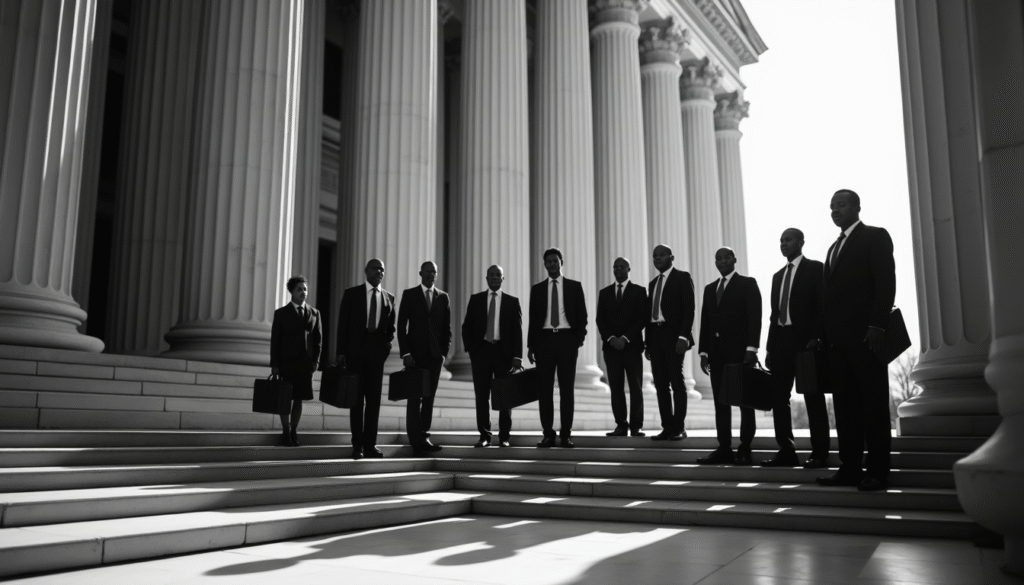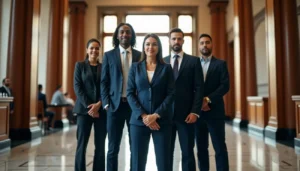NAACP Legal Defense Fund: The Untold Story Behind Civil Rights Victories
12 min read
The NAACP Legal Defense and Educational Fund stands as America’s premier legal organization fighting for racial justice, securing landmark victories that transformed civil rights in the United States. Since its founding in 1940, this powerhouse institution has won numerous Supreme Court cases, dismantling legal segregation and challenging systemic discrimination.
Throughout its history, the organization has served as more than just a law firm. Indeed, it has become the driving force behind major civil rights legislation, trained generations of civil rights attorneys, and continues to tackle modern challenges from voter suppression to educational inequality. This remarkable legacy of legal advocacy spans from the historic Brown v. Board of Education case to present-day battles for equal justice under law.
This article explores the untold story of how the NAACP Legal Defense Fund shaped American civil rights, examining its groundbreaking cases, policy victories, and ongoing fight for equality in the 21st century.
The Origins of the NAACP Legal Defense Fund
In the segregated America of 1940, a revolutionary legal organization was born that would forever change the landscape of civil rights litigation. The NAACP Legal Defense and Educational Fund emerged as a separate entity from its parent organization, created specifically to mount systematic legal challenges against racial discrimination across the United States.
Why the LDF was created in 1940
The NAACP Legal Defense and Educational Fund was established in 1940 as a tax-exempt corporation by the NAACP 1. This strategic decision came from financial and legal necessity rather than ideological differences. The board of directors of the NAACP created the Legal Defense Fund specifically for tax purposes 1, allowing the organization to receive tax-exempt donations dedicated to their growing litigation efforts 2.
Additionally, the creation of a separate “legal wing” under independent leadership addressed concerns that potential legal battles might discourage donations to the NAACP itself 3. By establishing a distinct entity focused solely on litigation, the organization could protect its financial resources from attack while pursuing aggressive legal strategies 3.
The charter for this groundbreaking institution was handwritten by Thurgood Marshall in March 1940, clearly stating its dual purpose: to provide legal aid to Black Americans “suffering legal injustices by reason of race or color” and to create educational opportunities for Black Americans denied access because of racial discrimination 4. This mission perfectly aligned with the social change agenda already established by NAACP attorneys in American courts 4.
Although initially operating as the legal arm of the NAACP, the LDF became completely separate in 1957 with its own leadership and board of directors 5. This formal separation financially benefited the LDF as public interest in landmark cases brought increasing donations specifically for legal advocacy 3.
Thurgood Marshall’s vision and early leadership
Thurgood Marshall, who would later become the first African-American U.S. Supreme Court Justice, served as the first Director-Counsel of the LDF from its founding until 1961 5. Under his visionary leadership, the organization developed a meticulous strategy to dismantle segregation through systematic legal challenges.
Marshall’s approach was both brilliant and methodical. As the key strategist in efforts to end racial segregation, he meticulously challenged the “separate but equal” doctrine established in Plessy v. Ferguson 5. His legal brilliance led to a remarkable record—winning twenty-nine of the thirty-two civil rights cases he argued before the Supreme Court 6.
Furthermore, Marshall’s commitment went beyond courtroom strategy. He constantly traveled to small, dusty, scorching courtrooms throughout the South, at one point overseeing as many as 450 simultaneous cases 5. This extraordinary workload demonstrated both his dedication and the overwhelming need for legal representation in civil rights matters.
By 1945, Marshall had already earned a reputation as a prominent figure in the civil rights movement after winning numerous cases involving unequal salaries for African Americans and ending salary disparities in major Southern cities 6. His growing influence and strategic vision positioned the LDF as “the legal arm of the civil rights movement” with a tradition of expert legal advocacy in the Supreme Court and courts across the nation 7.
Marshall’s founding vision for the LDF was transformative—to achieve racial justice, equality, and an inclusive society at a time when the nation’s aspirations for equality were stifled by widespread state-sponsored racial inequality 8. This bold mission would soon lead to legal victories that would establish the foundations for civil rights that all Americans enjoy today 8.
Breaking Legal Ground: Landmark Cases That Changed America
Through a series of groundbreaking cases, the NAACP Legal Defense Fund permanently altered America’s legal landscape, challenging discriminatory practices that had persisted for generations. The organization’s legal strategy, conceived by Charles Hamilton Houston and executed by Thurgood Marshall, systematically dismantled segregation through carefully selected test cases that targeted different aspects of racial discrimination.
Brown v. Board of Education and school desegregation
The landmark Brown v. Board of Education case stands as the LDF’s most celebrated victory. More than a single lawsuit, Brown was actually a coordinated group of five cases against school districts in Kansas, South Carolina, Delaware, Virginia, and Washington, D.C. 9. On May 17, 1954, the Supreme Court unanimously declared the “separate but equal” doctrine unconstitutional 9.
To win this momentous case, Thurgood Marshall assembled an exceptional legal team including Robert Carter, Jack Greenberg, Constance Baker Motley, and many others 9. Their argument was straightforward yet powerful: the 14th Amendment guarantees equal protection under the law, and racial segregation violated that principle 9.
Notably, the LDF incorporated groundbreaking social science research, including psychologists Kenneth and Mamie Clark’s doll experiments, which demonstrated how segregation led Black children to view themselves as inferior to their white peers 9. The Supreme Court cited this research in its decision 9.
Shelley v. Kraemer and housing discrimination
In 1948, the LDF won another crucial victory in Shelley v. Kraemer, which addressed racially restrictive housing covenants. The case began when an African-American family named Shelley purchased a house in St. Louis in 1945, unaware it was subject to a 1911 covenant preventing “people of the Negro or Asian Race” from occupying the property 10.
When a white neighbor, Louis Kraemer, sued to prevent the Shelleys from moving in, the case eventually reached the Supreme Court 10. In a unanimous decision, Chief Justice Fred Vinson ruled that while private parties might voluntarily abide by such covenants, judicial enforcement by courts constituted unconstitutional state action under the 14th Amendment 11.
This decision dealt a significant blow to housing segregation, eliminating a common method of promoting racial residential segregation 12. As a result, the case helped strengthen the Equal Protection Clause 12, though racially restrictive covenants weren’t officially made illegal until the Fair Housing Act of 1968 11.
Smith v. Allwright and voting rights
In 1944, Thurgood Marshall secured another momentous victory in Smith v. Allwright, which Marshall himself considered “his most important case” 13. The suit challenged Texas’s Democratic primary system that prohibited Black voters from participating 13.
The Supreme Court ruled 8-1 that the Texas Democratic Party’s whites-only policy violated the 14th and 15th Amendments 14. The Court declared: “The United States is a constitutional democracy. Its organic law grants to all citizens a right to participate in the choice of elected officials without restriction by any state because of race” 15.
Following this ruling, Black voter registration in the South increased dramatically—from 200,000 in 1940 to approximately 800,000 by 1948, and to over one million by 1952 14. Marshall called the case “a giant milestone in the progress of Negro Americans toward full citizenship” 13.
Furman v. Georgia and the death penalty
In 1972, the LDF achieved a historic—albeit temporary—victory against capital punishment in Furman v. Georgia 16. Led by Director-Counsel Jack Greenberg, the organization successfully argued that the death penalty was applied arbitrarily and disproportionately against marginalized groups, particularly Black Americans 16.
In a 5-4 decision, the Supreme Court ruled that the death penalty as then administered constituted cruel and unusual punishment, violating the 8th and 14th Amendments 16. This decision resulted in the commutation of 629 death row sentences 17 and marked the first and only nationwide halt to executions in the United States 16.
Unfortunately, this victory proved short-lived. In 1976, Gregg v. Georgia reinstated capital punishment after states rewrote their death penalty statutes to address the Court’s concerns 16. Nevertheless, the LDF continues its fight against capital punishment, maintaining that the death penalty remains infected with fundamental flaws, including persistent racial discrimination 16.
From Courtroom to Capitol: Expanding Civil Rights Through Policy
Beyond the courtroom battles, the NAACP Legal Defense Fund’s influence extended into the halls of Congress, where legal victories became the foundation for transformative federal legislation. As the organization secured landmark rulings, it simultaneously built political capital to reshape American civil rights policy.
How litigation influenced federal civil rights laws
The LDF’s strategic litigation created legal precedents that ultimately demanded legislative action. Their courtroom victories exposed the constitutional contradictions of segregation, consequently forcing Congress to address systemic discrimination through comprehensive legislation.
Brown v. Board of Education, in particular, created irresistible momentum for federal intervention. After this ruling established segregation’s inherent unconstitutionality, Congress faced mounting pressure to codify civil rights protections more broadly. This legal-to-legislative pipeline became the LDF’s most effective strategy for lasting change.
Jack Greenberg, who succeeded Thurgood Marshall as Director-Counsel, recognized this potential. Under his leadership, the LDF developed cases like Griggs v. Duke Power Company that would “create a legal framework for determining racial discrimination in the workplace that endures today.” This landmark employment discrimination case gave practical enforcement power to the Civil Rights Act’s workplace protections.
The LDF’s Washington, D.C. presence became “an essential component of our nation’s civil rights progress.” Their expertise proved invaluable as they worked “to ensure that major civil rights laws including the Elementary and Secondary Education Act, the Fair Housing Act, the Voting Rights Act, and the Civil Rights Act of 1964, among others were passed, reauthorized, and expanded.”
LDF’s role in shaping the Civil Rights Act and Voting Rights Act
The Civil Rights Act of 1964, signed by President Lyndon Johnson on July 2, 1964, was a direct product of LDF’s legal groundwork. The organization “played a crucial role in the law’s drafting and passage and, later, in shaping how courts enforce it.” LDF founder Thurgood Marshall worked alongside attorney Constance Baker Motley, Dr. Martin Luther King, Jr., and Representative John Lewis to “create and codify the legislation.”
Likewise, events in Selma, Alabama in 1965 “galvanized the passage of the Voting Rights Act of 1965,” which the LDF had repeatedly used “to safeguard citizens’ voting rights and ensure more inclusive democratic governance.” The organization had established the legal foundation through cases like Smith v. Allwright, making the VRA’s passage both possible and necessary.
The LDF’s dual approach—courtroom victories followed by legislative advocacy—created a self-reinforcing cycle of progress. Each legal precedent strengthened the case for federal legislation, while each new law provided additional tools for future litigation.
Modern Legal Battles and the Fight for Equality Today
Continuing its storied legacy, the NAACP Legal Defense Fund now wages battles in contemporary courts against evolving forms of discrimination. The organization tackles persistent challenges to racial equality through strategic litigation that addresses modern manifestations of historical problems.
Recent cases on voter suppression and redistricting
In 2021, the Legal Defense Fund filed lawsuits challenging Alabama’s congressional and state legislative redistricting plans, arguing they denied Black residents equal opportunity to participate in the political process. The suits charged that Alabama’s maps intentionally “pack and crack” Black communities, violating Section 2 of the Voting Rights Act and the 14th Amendment 1. Similarly, the LDF challenged Louisiana’s congressional maps, successfully advocating for a second majority-Black district after demonstrating that Black Louisianans, who comprise one-third of the state’s population, were limited to just 1 out of 6 congressional districts 3.
Moreover, in 2025, the organization filed a federal lawsuit against Fayette County, Tennessee, challenging an electoral map that left Black voters—who make up more than a quarter of the county’s population—with zero representation on the 19-member, all-white county commission 2.
COVID-era voting rights litigation
During the COVID-19 pandemic, the LDF moved swiftly to protect voting rights amid unprecedented public health challenges. In 2020, they filed federal lawsuits against Louisiana, South Carolina, and Texas, challenging voting requirements that put citizens at risk during the pandemic 18.
The Louisiana lawsuit sought expanded absentee ballot access, noting that existing restrictions would “effectively prevent thousands of voters from being able to participate in these upcoming elections or force them to risk their lives to do so” 18. Subsequently, in Harding v. Edwards, a federal court ordered Louisiana to provide both expanded qualifications for absentee voting and three extra days of early in-person voting 19.
Challenges to affirmative action and education equity
Following the Supreme Court’s 2023 decision striking down race-conscious admissions at Harvard and UNC, the Legal Defense Fund took immediate action. LDF’s Director of Strategic Initiatives, Jin Hee Lee, emphasized that “regardless of the Supreme Court’s affirmative action decision, colleges and universities must do all they can to ensure equitable educational opportunities” 20.
In response, the LDF co-sponsored a comprehensive report with five other civil rights organizations offering recommendations for advancing educational equity within the new legal framework 20. The organization continues to maintain that “a true multiracial democracy cannot tolerate a segregated higher education system that closes the doors of opportunity to many talented students of color” 21.
Building a Legacy: Education, Research, and Future Leaders
Alongside its groundbreaking legal work, the NAACP Legal Defense and Educational Fund invests in research and future talent—ensuring civil rights advocacy continues for generations to come.
The Thurgood Marshall Institute’s role in research and advocacy
Established in 2015 to commemorate the organization’s 75th anniversary, the Thurgood Marshall Institute (TMI) serves as the multidisciplinary research center within the NAACP Legal Defense Fund 6. This collaborative hub combines research expertise with LDF’s traditional litigation strengths to advance a modern vision of racial justice.
TMI strategically generates and integrates innovative research with advocacy materials, creating high-impact communications campaigns that educate both the public and key decision makers 6. The institute recently released “Attack on Our Power and Dignity: What Project 2025 Means for Black Communities,” offering the most comprehensive legal analysis of how Project 2025 would impact Black Americans 22.
Additionally, the Thurgood Marshall Institute Social Science Review (TMISSR) hosts diverse content ranging from reports and briefs to toolkits and podcasts—all addressing LDF’s core focus areas: voting rights, criminal justice reform, education equity, and economic justice 23.
Scholarship programs and legal training for Black students
For decades, the NAACP Legal Defense Fund has nurtured aspiring civil rights attorneys through substantial financial support programs. The Herbert Lehman Education Fund provides undergraduates with $3,000 annually for four years, totaling $12,000 per student 24. Law students can receive even greater support through the Earl Warren Scholarship, which awards $15,000 annually for three years, totaling $45,000 25.
Remarkably, over its 50-year history, LDF’s scholarship initiatives have provided more than $5.5 million to over 1,950 students 26. In 2021, the organization dramatically expanded this commitment by launching the Marshall-Motley Scholars Program with $40 million from an anonymous donor 27. This ambitious initiative will fund 50 aspiring civil rights lawyers over two decades, including fully funding law school, summer internships, and two-year postgraduate fellowships 27.
These scholarship recipients commit to practicing civil rights law for at least eight years after completing the program, specifically focusing on racial justice in the South 27—thereby ensuring that LDF’s legacy continues through new generations of dedicated advocates.
Conclusion
Throughout its eight-decade history, the NAACP Legal Defense Fund has fundamentally transformed American civil rights through strategic litigation, policy advocacy, and unwavering dedication to racial justice. Starting with Thurgood Marshall’s groundbreaking victories, the organization dismantled legal segregation case by case, establishing precedents that shaped landmark legislation like the Civil Rights Act and Voting Rights Act.
Today, LDF continues this essential work, tackling modern manifestations of discrimination through challenges to voter suppression, unfair redistricting, and educational inequity. Their comprehensive approach combines courtroom advocacy with research through the Thurgood Marshall Institute while building future leadership through substantial scholarship programs.
The organization’s enduring impact extends beyond individual court victories. LDF’s strategic combination of litigation, policy advocacy, and talent development has created lasting change in American society. Though significant challenges remain, the NAACP Legal Defense Fund stands ready to defend civil rights and pursue racial justice for generations to come.
References
[1] – https://voting.naacpldf.org/census-and-redistricting/redistricting/current-redistricting-litigation/
[2] – https://tennesseelookout.com/briefs/naacp-legal-defense-fund-sues-fayette-county-over-discriminatory-2021-electoral-map/
[3] – https://www.naacpldf.org/case-issue/robinson-v-landry-louisiana-discriminatory-redistricting/
[4] – https://www.ebsco.com/research-starters/history/national-association-advancement-colored-people-legal-defense-and
[5] – https://www.naacpldf.org/about-us/history/thurgood-marshall/
[6] – https://www.naacpldf.org/about-us/careers/education-equity-senior-research-temporary/
[7] – https://www.naacpldf.org/85years/
[8] – https://www.naacpldf.org/about-us/history/
[9] – https://www.naacpldf.org/brown-vs-board/
[10] – https://supreme.justia.com/cases/federal/us/334/1/
[11] – https://en.wikipedia.org/wiki/Shelley_v._Kraemer
[12] – https://www.law.cornell.edu/wex/shelley_v_kraemer_(1948)
[13] – https://www.naacpldf.org/case-issue/landmark-smith-v-allwright/
[14] – https://en.wikipedia.org/wiki/Smith_v._Allwright
[15] – https://supreme.justia.com/cases/federal/us/321/649/
[16] – https://www.naacpldf.org/case-issue/furman-v-georgia/
[17] – https://www.naacpldf.org/our-thinking/death-row-usa/
[18] – https://www.naacpldf.org/press-release/ldf-files-federal-lawsuit-challenging-louisiana-voting-requirements-that-put-voters-at-risk-amid-covid-19-pandemic/
[19] – https://www.naacpldf.org/case-issue/harding-v-edwards/
[20] – https://www.naacpldf.org/press-release/civil-rights-groups-send-post-affirmative-action-report-to-harvard-unc-and-over-100-additional-colleges-and-universities-detailing-options-for-equitable-and-diverse-higher-education-after-the/
[21] – https://www.naacpldf.org/wp-content/uploads/Affirmative-Action-What-You-Need-To-Know-2023-06-1.pdf
[22] – https://www.naacpldf.org/press-release/ldf-thurgood-marshall-institute-releases-new-report-what-project-2025-means-for-black-communities/
[23] – https://www.ssrn.com/index.cfm/en/thurgood-marshall-res/
[24] – https://naacp-ldf.smapply.io/prog/herbert_lehman_education_fund/
[25] – https://www.naacpldf.org/about-us/scholarships/earl-warren-scholarship/
[26] – https://www.naacpldf.org/about-us/ldf-scholarships/
[27] – https://www.cnn.com/2021/01/23/us/naacp-legal-defense-fund-scholarship-trnd/index.html
More on Afrishervi







